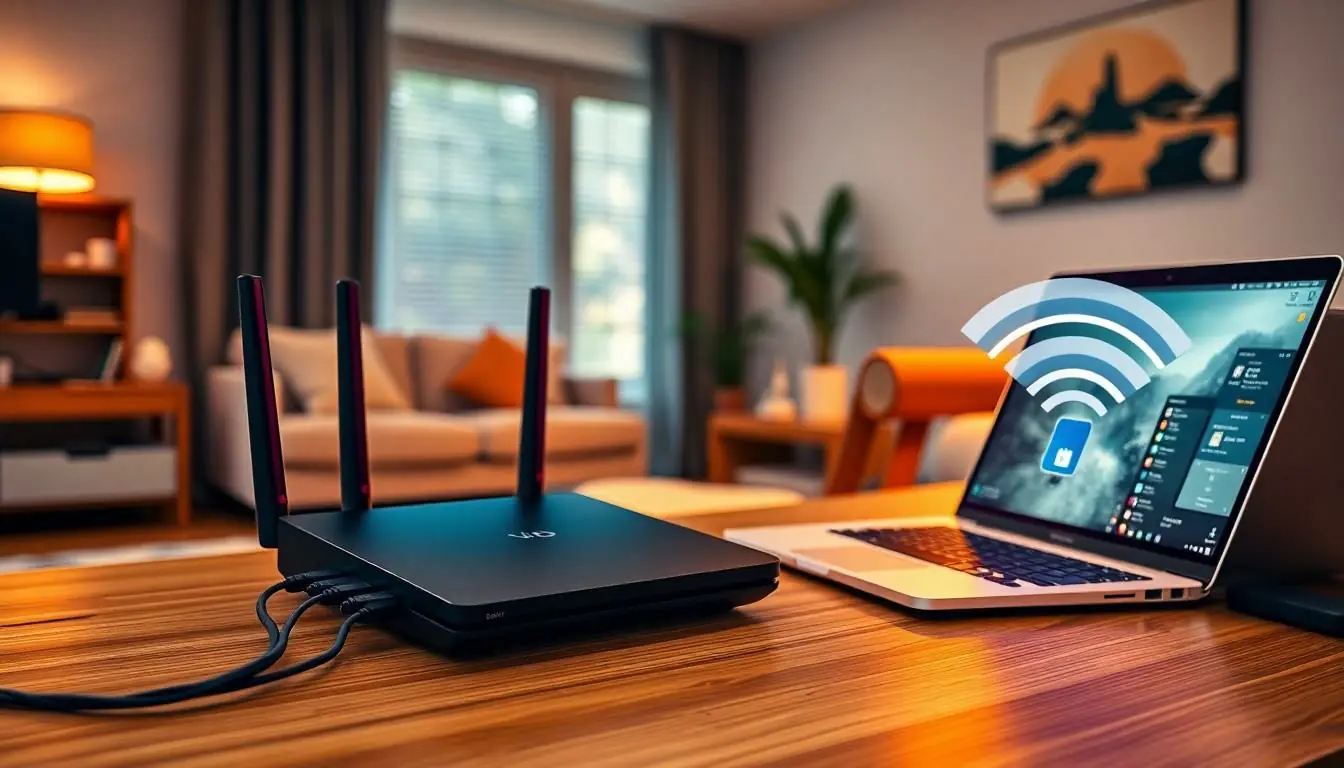Table of Contents
ToggleIn today’s digital age, networking isn’t just for the office anymore. It’s time to bring those connections home and transform your living space into a hub of productivity and creativity. Imagine streaming your favorite shows without buffering while your kids game in the next room—all thanks to a well-planned home network. Sounds dreamy, right?
But let’s face it, setting up a home network can feel like deciphering ancient hieroglyphics. With the right tips and tricks, though, anyone can master the art of home networking. Whether you’re a tech whiz or someone who still thinks “Wi-Fi” is a fancy coffee order, this guide will help you navigate the world of home connectivity. Get ready to boost your internet speed, eliminate dead zones, and impress your friends with your newfound tech-savvy skills.
Understanding Networking For Home
Home networking involves connecting devices within a residence, allowing for seamless communication and internet access. This setup enhances the overall digital experience, making it essential in today’s connected world.
What Is Home Networking?
Home networking constitutes a library of interconnected devices that share internet connections and resources. Routers serve as a central hub, distributing internet signals to devices like smartphones, laptops, and smart TVs. A well-organized home network boosts productivity, providing convenient access to shared files and printers. By integrating various devices, individuals enjoy a cohesive home ecosystem that supports multiple online activities simultaneously.
Key Components of Home Networking
Key components of home networking include routers, switches, and access points. Routers connect homes to the internet, facilitating wireless access for various devices. Switches, in contrast, link multiple wired devices within a network, ensuring efficient data transfer. Access points extend the wireless network’s reach, eliminating dead zones and enhancing coverage throughout the home. Implementing these components optimally allows for improved speed and connectivity, further enriching the digital experience.
Setting Up Your Home Network

Establishing a home network empowers users to seamlessly connect multiple devices for a richer digital experience. Proper setup enhances productivity and optimizes entertainment options.
Choosing the Right Equipment
Selecting the right equipment serves as the foundation for any successful home network. Consider using a dual-band router, which supports both 2.4 GHz and 5 GHz frequencies, allowing for better speed and reduced interference. Assess the size of the space when opting for a router or access point; larger homes may require additional units for optimal coverage. Routers with built-in security features protect devices from potential threats, ensuring a safe online environment. Incorporate quality Ethernet cables for wired connections, which offer faster speeds and more stable connections compared to Wi-Fi.
Configuring Your Network Settings
Configuring network settings is essential for maximizing performance. Start by accessing the router’s admin interface through a web browser using its IP address. Change the default username and password to enhance security. Enable WPA3 encryption for a robust layer of protection against unauthorized access. Adjust the channel settings to reduce interference from neighboring networks, improving overall connectivity. Set up a guest network to keep personal devices separate from visitors, maintaining privacy. Regularly update firmware to ensure all devices operate smoothly and securely.
Common Networking Protocols
Home networks rely on various networking protocols to ensure reliable communication among devices and optimized internet access. Understanding these can help individuals make informed decisions when setting up their systems.
Wired vs. Wireless Networking
Wired networking employs Ethernet cables to connect devices directly to a router. This method provides higher speed and stability, making it ideal for data-intensive tasks like gaming or streaming. Wireless networking, on the other hand, uses Wi-Fi signals for connection, allowing for more flexible placement of devices. While wireless connections enable mobility within the home, they may suffer from interference and varied speeds depending on distance from the router. Each method serves different needs, so selecting the right option enhances the home network experience.
Understanding Network Protocols
Network protocols define the established rules for data transmission across networks. Common protocols include TCP/IP and HTTP, forming the backbone of Internet communication. TCP/IP governs how data is packaged and transmitted, ensuring reliable connections. HTTP facilitates data transfer between web servers and browsers, essential for accessing online content. Knowing these protocols helps users troubleshoot connectivity issues, optimize performance, and choose compatible devices. Integrating proper protocols can strengthen home network efficiency and security.
Enhancing Your Home Network Security
Securing a home network is essential for protecting personal data and connected devices. Network security prevents unauthorized access and potential cyber threats.
Importance of Network Security
Network security safeguards sensitive information from hackers and other cybercriminals. It helps maintain the integrity of connected devices like smart appliances, computers, and security systems. Concerns arise as attacks on home networks increase. A breach may lead to identity theft, data loss, or unauthorized control over devices. Thus, establishing strong security measures is crucial in protecting against these risks.
Tips for Securing Your Home Network
Securing a home network involves several key practices. Start by changing the default login credentials of your router, as those are often easily exploited. Use a strong, unique password for Wi-Fi access and avoid common phrases. Enable WPA3 encryption for improved security against unauthorized intrusions. Regular firmware updates enhance router performance and patch vulnerabilities. Additionally, consider disabling remote access features unless necessary. Implementing a guest network allows separate access for visitors without compromising the main network. Following these steps significantly boosts overall security for any home network.
Troubleshooting Networking Issues
Troubleshooting networking issues can resolve connectivity problems and enhance performance in a home network. Identifying common challenges helps streamline solutions.
Common Problems and Solutions
Network connectivity often suffers due to several common problems. Slow internet speed can arise from bandwidth limitations. To address this, prioritizing high-bandwidth activities, such as streaming or gaming, ensures smoother performance. Dead zones frequently disrupt wireless signals. Positioning the router centrally or utilizing Wi-Fi extenders can effectively eliminate dead zones. Devices may struggle to connect due to outdated firmware. Regularly updating firmware helps maintain optimal performance and security. Additionally, interference from other electronic devices can negatively impact connectivity. Changing the router’s channel settings minimizes interference and significantly improves connection stability.
Tools for Network Troubleshooting
Several tools facilitate effective network troubleshooting. Network analyzers, such as Wireshark, provide valuable insights into network activity and potential issues. Ping and traceroute are essential for diagnosing connectivity issues, enabling users to check the status of network connections. Speed test websites, like Ookla, measure internet speed, helping users understand bandwidth availability. For wireless network analysis, tools like NetSpot or Acrylic Wi-Fi optimize signal strength and identify dead zones. Device management apps also offer a user-friendly interface for monitoring connected devices and adjusting settings. Regularly utilizing these tools enhances network reliability and performance, ensuring a seamless digital experience at home.
Mastering home networking is essential for anyone looking to enhance their digital experience. With the right tools and knowledge, it’s possible to create a robust network that supports multiple devices seamlessly. Implementing strong security measures protects personal data while troubleshooting common issues ensures a reliable connection.
By investing time in understanding networking basics and following best practices, individuals can enjoy faster internet speeds and eliminate frustrating dead zones. This not only boosts productivity but also enriches leisure activities like streaming and gaming. Embracing these strategies empowers users to navigate the digital landscape with confidence, making home networking an invaluable asset in today’s connected world.



